Luxor Temples Guide
1. Introduction to Luxor’s Temples
Come on in and get yourself comfortable and ready to explore the marvel of ancient Egypt at its prime; it contains some of the most astonishing paintings and statues ever constructed in the beautiful Temples in Egypt. Called “the open air museum of the world”, Luxor possesses some of the most marvelous Temples ever erected, each one has a story to tell about the gods, the rulers, and the mother of all the Nile River. Luxor temples Guide is essentially a living edifices, which not only commemorate the greatness of the ancient Egyptian culture but also the zeal that made up this culture.
The East Bank will not be satisfying without a tour in the ever grand Karnak Temple. It is simply the biggest sanctuary complex of a few religions ever put all together. Each section can be attributed to a particular king and thus and thus, their architectural plan, even for the later additions, has been maintained.
Close to it on the east happens to be the temple of Luxor, which made long endeavors to make it appear splendid once more, and relate to the Theban triad. Within what was in those times the sacred axis of ancient Thebes, stood these temples, which were cut off by an avenue of Ibises, a human-made structure that was rebuilt to be open to the public view again.
It’s like time never moved when you visit the temples in Luxor. Every part of the monuments is beautiful, and when you look a little closer, the significance of each pylon, statue, and depiction in the ancient language starts to be appreciated. Irrespective of whether you are browsing the Luxor Temples Guide or going further into details through the Karnak Temple guide, these places guarantee a journey to be remembered for long into ancient times.
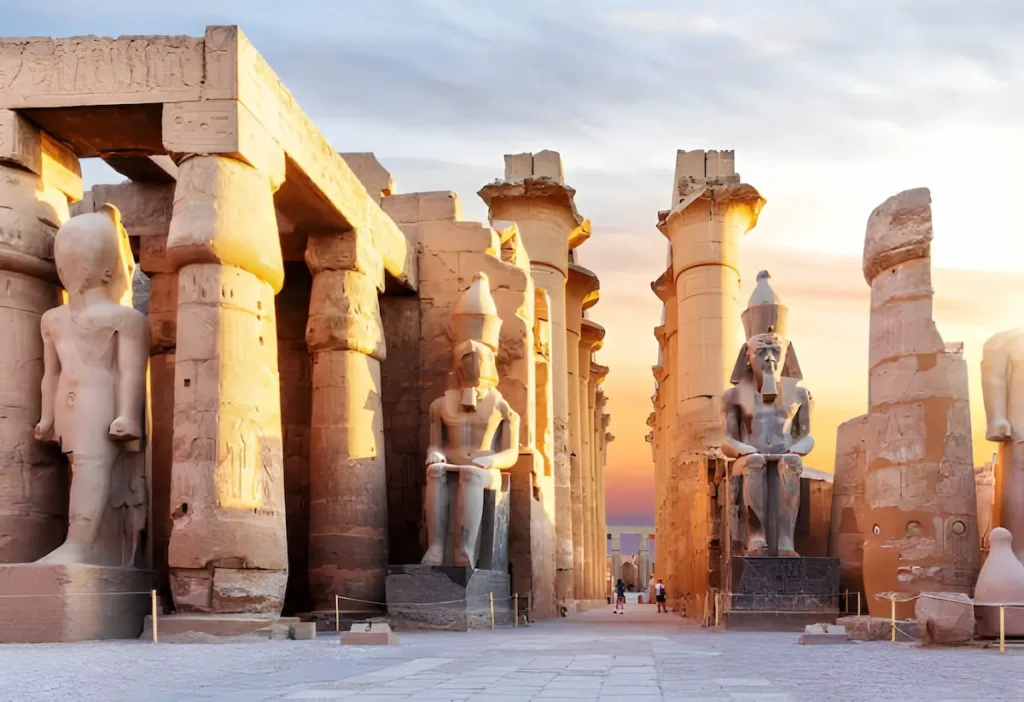
2. Must-See Temples in Luxor
a) Karnak Temple Complex Guide
Karnak Temple Complex is one of the most impressive historical sites in Egypt and is among the highlights of any Luxor Temples Guide. The largest in Egypt, the temple was dedicated to the Theban Triad of Amun-Ra, Mut, and Khonsu, and also represents over two thousand years of varied construction that succeeded the original structure. Walking around the vicinity of Karnak can feel like experiencing a living history.
What promises to wow is the striking, high-columned Great Hypostyle Hall, whose 134 huge columns narrate the stories of divine laws and traditions, as well as the divine power. Next to each other, the priests’ clean buddy, the Sacred Lake, which was used for cleaning rituals of the priests, and now allows you to sit silently and contemplate the unbelievable beauty of the temple.
In order to make your travel experience even more fulfilling and interactive within the temple of Karnak, try the Sound and Light Show at Karnak, where you get to appreciate the historical background through emotions and sound. You would find more about the exciting night event in our Luxor Night Tours guide.
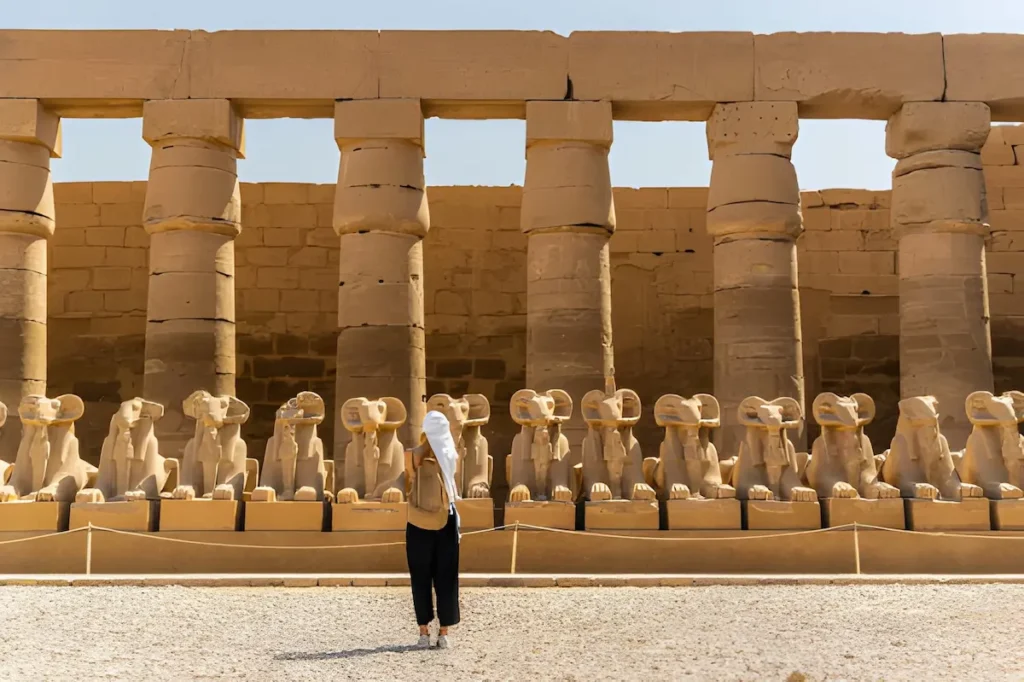
b) Luxor Temples
luxury resort facilities. Inaugurated under Amenhotep III and completed under Ramses II, the Luxor Temple in Egypt was one of the major scenes of the Opet Festival, a grand religious parade that connected it to the Karnak Temple via a path of fashioned and sculptured Sphinxes is one of the most representative constructions of the New Kingdom. During the festive day, the statues of the gods Amun, Mut, and Khonsu were transferred from Karnak to Luxor to refresh the pharaoh’s divine essence.
There is something absolutely mesmerizing about wandering the site when the sun is going down, the statues, the walls, the columns, and everything else is just all aglow under the increasingly amber lights, while the midafternoon prayers are discerned, quite melancholy at times, and have a cathedral quality to them. Wherever you are placed, the illuminated columns and obelisks provide a highly intriguing ambiance, which marries the Egyptian culture of old and the living one of contemporary Egypt. For more ideas on what to do and where to visit at night, please take a look at one of the following articles: Luxor Night Tours.
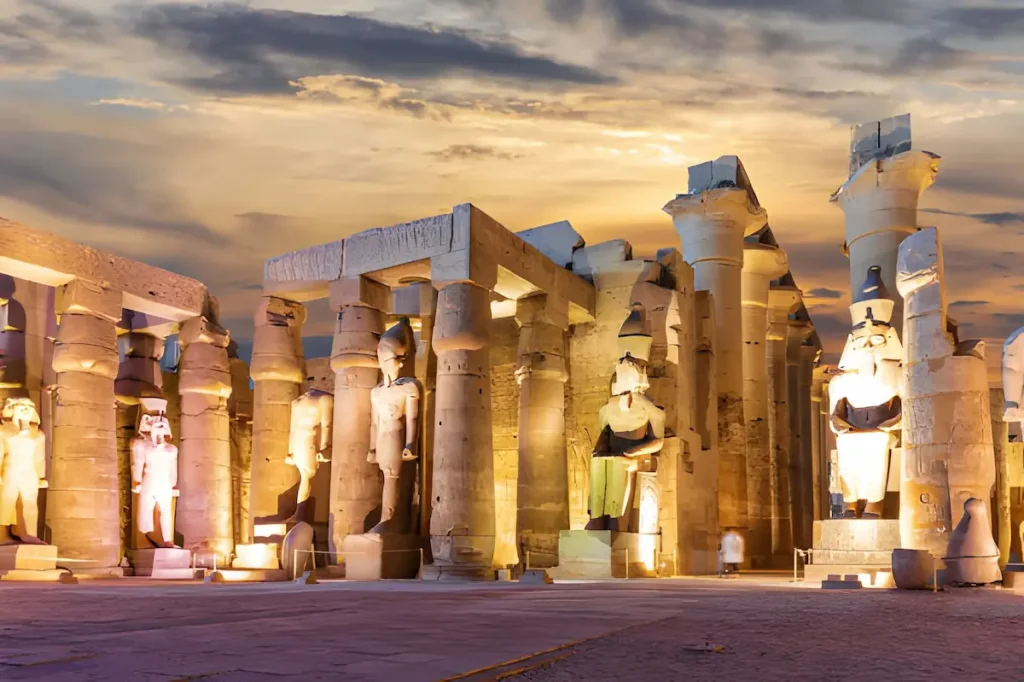
c) Hatshepsut Temple (Deir el-Bahari)
The astonishing Temple of Hatshepsut, situated on the cliffs of Deir el-Bahari, is an uncalled souvenir of the history and architecture of ancient Egypt. It was dedicated to one of the most prominent queens of Egypt: Hatshepsut. With her ambitions and divine claims, she embraced Amun and built this temple. It is truly difficult to find more photogenic, better terraces than these from where one can view the morning sun.
Here, the stone facades describe the miraculous birth of the queen and her legendary trip to the land of Punt all of which paint a picture of how her rule was admired in a male-dominated society How to enjoy its calmness and avoid getting stuck in large groups is by visiting such places in the morning when the sunlight falls on the rocks bathing them in soft red, orange, or even reds and browns. This is the place to be for enthusiasts and students of the Luxor temples.
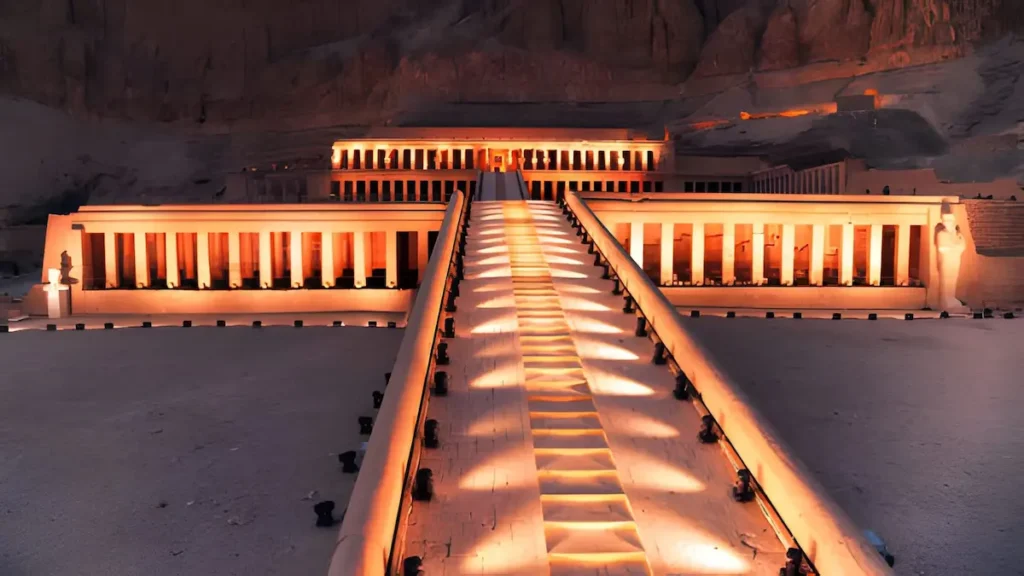
d) Medinet Habu
Medinet Habu is an Egyptian temple that can be recognized as a must-see monument in the city. This temple, created under the reign of Ramses III, was the original focus of both cultic and political activities, illustrating the heroic nature of the last, most fulfilling pharaoh in ancient world history, Ramses III.
Covering the immense area with its walls, reliefs representing a lot of scope, recording the numerous triumphs achieved in foreign wars, ceremonies implied in religious dogma, and sacrifices have been identified. What is more, some of these pictures have been confirmed to have been painted in the same way they were painted in ancient Egypt, and this is one feature about Medinet Habu, which places it very high as one of the preserved ancient temples in Thebes. Also, this is through stopping, though still present, but not as much as temples like Karnak and Luxor temples, but here there is peace, which beckons and helps in examining.
Text-described images of Medinet Habu will lure the most enthusiastic photographers. But if you would rather visit less broad attractions, just like me, I suggest you put Medinet Habu, a collection of beautifully preserved marble temples, right in the core of the Luxor Temples Guide book.
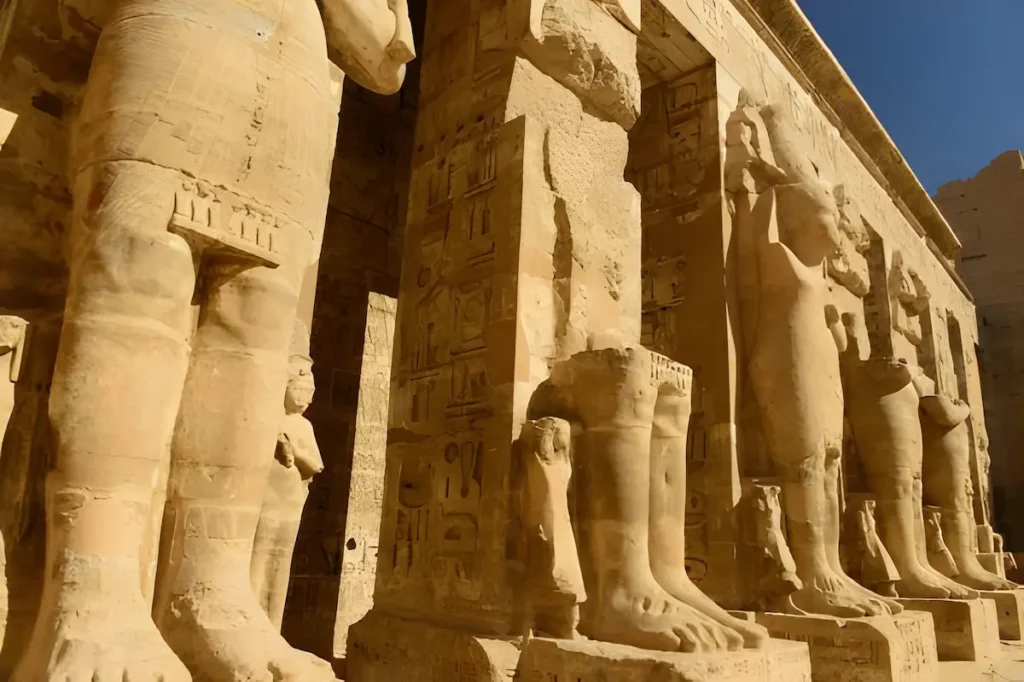
3. Hidden Gems: Lesser-Known Temples
Beyond the famous Karnak and Luxor temples, the city harbors some less famous sanctuaries that deserve a place in any Luxor Temples Guide. On the West Bank, the Temple of Seti I is known for having fine and delicate artistry in its adornments and well-preserved reliefs attesting to the artistic genius of the New Kingdom. Nearby, the Temple of Mut, part of the greater Karnak complex, was once an influential cult center honoring the goddess Mut, wife of Amun, with sacred pools and statues that may parallel the divine feminine power of Egypt.
Some smaller mortuary temples and chapels scattered within the necropolis of Luxor offer peaceful discovery for photographers and historians alike. For the best experience, pair these smaller wonders with nearby tombs such as the Valley of the Nobles or Valley of the Queens for a full-day Luxor temples tour.
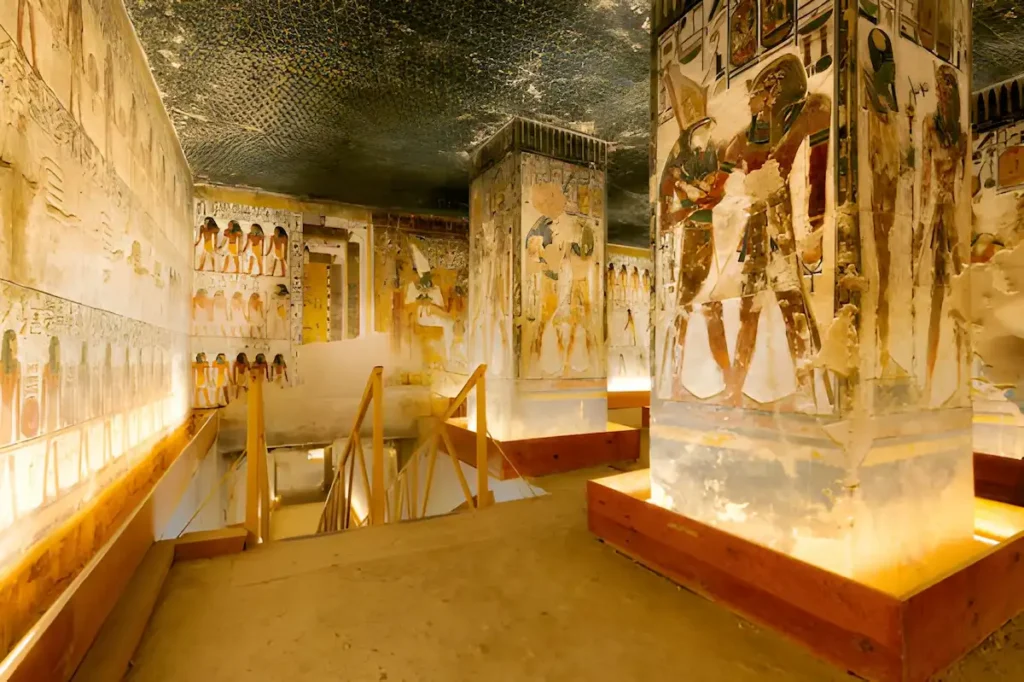
Temple of Seti I
4. Practical Visiting Tips
Making the best out of Luxor temples largely hinges on the time of visit and preparation. The prime months of visiting are from October to April, as during this period the weather is ideal for sprawling temple site explorations. Morning starts are now always recommended for you to be ahead of the crowd, and also to catch our photographer’s soft oil light.
The Luxor Pass is a very convenient way of seeing the temples, as it offers discounted prices for combined entry into many temples and archaeological sites. Dress appropriately yet comfortably-light breathable materials, sun hats, and walking shoes are advised. Always carry water and sunblock, as shade is minimal.
Photography is generally allowed in most areas. Do remember to respect restricted areas and do not use flash around delicate reliefs. Your guide must be licensed; knowledgeable guides greatly enhance your appreciation of the symbology and history of all sites to make your Luxor Temples Guide an informative and unforgettable experience.
5. Combining Temples with Other Luxor Experiences
The temple sites in Luxor never cease to amaze. However, attaching a few more tourist activities to the visit surely puts an unforgettable dent into any trip. Instead, ponder going through your morning at Karnak Temple by wandering through the massive Hypostyle Hall or along the sacred lake before lunchtime, really allows the heat to set in! Post-lunch along the Nile Corniche leads either to a sunset felucca ride or a private cruise along the Nile River. With the sunset aglow in the city, the glimmering reflection of the temple on the river offers one of the most charming moments to witness in Luxor.
Beyond that, for those who might have an extended duration for sightseeing, a Nile Cruise is the ultimate way to combine temples at Luxor, Edfu, Kom Ombo, and Aswan, which is also the route once taken by the pharaohs! The evening visitors shouldn’t ever stop missing the mesmerizing Sound & Light Show at the Karnak Temple-a stunning trail of history under the stars. Further complete your itinerary through our Luxor Night Tours guide.
If one likes culture, romance, or relaxation, combining the Luxor temples with Nile experiences or night tours guarantees the very lifeblood of Egypt’s timeless charm. For well-made experiences, have a look at our Nile Cruise Packages, which provide there is something for every traveler’s style.
6. FAQs About Luxor Temple Egypt
How long should I spend at each temple?
Each temple in Luxor deserves unhurried exploration. Spend at least two hours at major sites like Karnak Temple and Luxor Temple in Egypt, where vast courtyards, intricate carvings, and hieroglyphs await. Smaller yet fascinating temples, such as Medinet Habu or the Temple of Seti I, can be explored in about an hour, especially if you enjoy photography or detailed wall art.
Which temples are open at night?
Currently, Luxor Temple welcomes visitors after sunset, offering stunning night views under soft illumination. The Karnak Sound & Light Show also provides an enchanting way to experience the temple’s history after dark. For more details, check our [Luxor Night Tours] guide.
Are guided tours worth it?
Absolutely. Hiring a professional Egyptologist transforms your visit into an immersive journey through history, revealing the meanings behind carvings and myths. Guided tours often include transportation, skip-the-line entry, and insider tips ideal for those who want to make the most of their Luxor temples adventure while gaining authentic local insights.
7. Conclusion & Call to Action
Exploring the Luxor temples is more of a cultural and historical excursion, if you will. The presence of Karnak is in itself awesome; however, appellez it has a divine elegance in its own right. From Hatshepsut Temple’s charm to the great gleaming stones of Karnak Temple and Luxor Temple Egypt, each temple was perhaps created under the watchful eye of gods, kings, or lasting devotion. These temples stand as intertwining windows into Egypt’s wonderful past, granting glimmering opportunities to tourists to stroll down memory lanes along with some pharaohs and priests.
The temple guide has been written for the historian, the photographer, and the first-time visitor to capture the surrounding aura of this ancient city with reverence and awe. There is hardly any feeling quite like standing under crying columns or watching the temples’ beauty gain color with sunset, knowing that the world has regarded Luxor as the “World’s Greatest Open-Air Museum.”
Let’s get ready to plan your trip. Find itineraries, tips, and ideas to plan your trip in our [Luxor Travel Guide 2025]-or simply book your temple tour with Middle East Voyager to discover the most iconic landmarks in Egypt alongside expert guides who provide in-depth knowledge of every stone and story.






